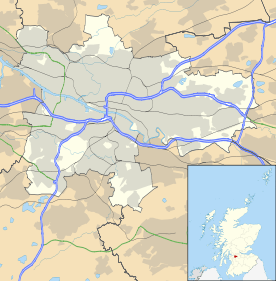Parkhead
| Parkhead | |
| Scots: Pairkheid | |
 Parkhead Cross, the traditional heart of the district |
|
 Parkhead |
|
| OS grid reference | NS625639 |
|---|---|
| Council area | Glasgow City Council |
| Lieutenancy area | Glasgow |
| Country | Scotland |
| Sovereign state | United Kingdom |
| Post town | GLASGOW |
| Postcode district | G31 |
| Dialling code | 0141 |
| Police | Scottish |
| Fire | Scottish |
| Ambulance | Scottish |
| EU Parliament | Scotland |
| UK Parliament | Glasgow East |
| Scottish Parliament | Glasgow Shettleston |
Coordinates: 55°50′55″N 4°11′52″W / 55.8486°N 4.1978°W
Parkhead (Scots: Pairkheid)[1] is a district in the East End of Glasgow. Its name comes from a small weaving hamlet at the meeting place of the Great Eastern Road (now the Gallowgate and Tollcross Road) and Westmuir Street. Duke Street and Springfield Road also meet there, to form a turreted Edwardian five-way junction at Parkhead Cross. Glasgow's Eastern Necropolis was laid out in 1847 beside the Gallowgate.[2]
History
The area flourished with the discovery of coal in 1837 and grew into an industrial centre. In 1897 William Beardmore and Company became famous with the production of high grade steel and castings at the local Parkhead Forge, founded about 1837 and extended between 1884 and 1914. After years of decline, the massive plant was closed in 1976, and in 1986 the construction of the first phase of The Forge Shopping Centre began on the site. The shopping centre opened in the autumn of 1988, and in 1994 an indoor market was added adjacent to it. The final element, a retail park, was completed in three stages between 1996 and 2002.
Hospitals
Belvidere Hospital, built on the Belvidere estate which extended from London Road to the Clyde, originally consisted of wooden huts thrown up rapidly when the city's older fever hospital at Parliamentary Road was overwhelmed by a typhus epidemic in 1870. A self-contained smallpox hospital of five brick pavilions was built from 1874. After this nineteen pavilions of red and white striped brick were set up for the fever hospital.[3] In recent times, with the general closure of infectious disease hospitals, care of elderly people became its main function before closing in 1999.
Parkhead Hospital,[4] which opened in November 1988, was said to be the only new psychiatric hospital to be built in Scotland in the 20th century. (However, some 18th and 19th century institutions did move to new buildings during the 20th century.) It was built on part of the old forge land, next to the Parkhead Health Centre, and replaced the psychiatric and psycho-geriatric admission wards of both Duke Street Hospital (formerly known as the Eastern District Hospital) and Gartloch Hospital. Both units moved into the new hospital on the day of a Rangers-Celtic match at the nearby Celtic Park.
Libraries
Parkhead also has one of Glasgow's original Carnegie libraries, deftly designed in the Edwardian Baroque style by James Robert Rhind.
Celtic FC
Parkhead is best known as the home of Celtic Football Club, Celtic Park,which opened in 1892 after the club moved across the road from their old ground which they had been playing on for their first three years. A journalist covering the event reported that it was like "moving from the graveyard to paradise", hence the nickname "Paradise." Celtic Park is located at 95 Kerrydale Street, just off the London Road in Parkhead. The stadium itself is commonly referred to as Parkhead because of its location.
Parkhead FC, prior to its dissolution, was arguably the most successful Scottish junior side.
Celtic F.C was founded in 1887 and didn't play their first match until 1888
Rail
There have been several railway stations in Parkhead.
References
- ↑ The Online Scots Dictionary
- ↑ Elizabeth Williamson, Anne Riches & Malcolm Higgs, The Buildings of Scotland: Glasgow. London: Penguin 1990 ISBN 0-14-071069-8
- ↑ Magnus Maclean, Archaeology, Education, Medical & Charitable Institutions of Glasgow. Glasgow: British Association 1901.
- ↑ Greater Glasgow Health Board Bulletin December 1988